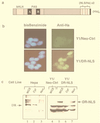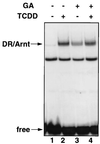Multiple roles of ligand in transforming the dioxin receptor to an active basic helix-loop-helix/PAS transcription factor complex with the nuclear protein Arnt
- PMID: 10409767
- PMCID: PMC84430
- DOI: 10.1128/MCB.19.8.5811
Multiple roles of ligand in transforming the dioxin receptor to an active basic helix-loop-helix/PAS transcription factor complex with the nuclear protein Arnt
Abstract
The dioxin receptor is a ligand-activated transcription factor belonging to an emerging class of basic helix-loop-helix/PAS proteins which show interaction with the molecular chaperone hsp90 in their latent states and require heterodimerization with a general cofactor, Arnt, to form active DNA binding complexes. Upon binding of polycyclic aromatic hydrocarbons typified by dioxin, the dioxin receptor translocates from the cytoplasm to the nucleus to allow interaction with Arnt. Here we have bypassed the nuclear translocation step by creating a cell line which expresses a constitutively nuclear dioxin receptor, which we find remains in a latent form, demonstrating that ligand has functional roles beyond initiating nuclear import of the receptor. Treatment of the nuclear receptor with dioxin induces dimerization with Arnt to form an active transcription factor complex, while in stark contrast, treatment with the hsp90 ligand geldanamycin results in rapid degradation of the receptor. Inhibition of degradation by a proteasome inhibitor allowed geldanamycin to transform the nuclear dioxin receptor to a heterodimer with Arnt (DR-Arnt). Our results indicate that unchaperoned dioxin receptor is extremely labile and is consistent with a concerted nuclear mechanism for receptor activation whereby hsp90 is released from the ligand-bound dioxin receptor concomitant with Arnt dimerization. Strikingly, artificial transformation of the receptor by geldanamycin provided a DR-Arnt complex capable of binding DNA but incapable of stimulating transcription. Limited proteolysis of DR-Arnt heterodimers indicated different conformations for dioxin versus geldanamycin-transformed receptors. Our studies of intracellular dioxin receptor transformation indicate that ligand plays multiple mechanistic roles during receptor activation, being important for nuclear translocation, transformation to an Arnt heterodimer, and maintenance of a structural integrity key for transcriptional activation.
Figures








Similar articles
-
A cellular factor stimulates ligand-dependent release of hsp90 from the basic helix-loop-helix dioxin receptor.Mol Cell Biol. 1994 Apr;14(4):2438-46. doi: 10.1128/mcb.14.4.2438-2446.1994. Mol Cell Biol. 1994. PMID: 8139547 Free PMC article.
-
Functional interference between hypoxia and dioxin signal transduction pathways: competition for recruitment of the Arnt transcription factor.Mol Cell Biol. 1996 Oct;16(10):5221-31. doi: 10.1128/MCB.16.10.5221. Mol Cell Biol. 1996. PMID: 8816435 Free PMC article.
-
Distinct roles of the molecular chaperone hsp90 in modulating dioxin receptor function via the basic helix-loop-helix and PAS domains.Mol Cell Biol. 1995 Feb;15(2):756-65. doi: 10.1128/MCB.15.2.756. Mol Cell Biol. 1995. PMID: 7823943 Free PMC article.
-
Mechanisms of ligand-induced aryl hydrocarbon receptor-mediated biochemical and toxic responses.Toxicol Pathol. 1998 Sep-Oct;26(5):657-71. doi: 10.1177/019262339802600510. Toxicol Pathol. 1998. PMID: 9789953 Review.
-
Effect of ARA9 on dioxin receptor mediated transcription.Toxicology. 2002 Dec 27;181-182:143-6. doi: 10.1016/s0300-483x(02)00270-6. Toxicology. 2002. PMID: 12505299 Review.
Cited by
-
Inhibition of Single Minded 2 gene expression mediates tumor-selective apoptosis and differentiation in human colon cancer cells.Proc Natl Acad Sci U S A. 2005 Sep 6;102(36):12765-70. doi: 10.1073/pnas.0505484102. Epub 2005 Aug 29. Proc Natl Acad Sci U S A. 2005. PMID: 16129820 Free PMC article.
-
Identification of Down's syndrome critical locus gene SIM2-s as a drug therapy target for solid tumors.Proc Natl Acad Sci U S A. 2003 Apr 15;100(8):4760-5. doi: 10.1073/pnas.0831000100. Epub 2003 Apr 3. Proc Natl Acad Sci U S A. 2003. PMID: 12676991 Free PMC article.
-
An aryl hydrocarbon receptor conformation acts as the functional core of nuclear dioxin signaling.Nucleic Acids Res. 2000 Jun 15;28(12):2286-91. doi: 10.1093/nar/28.12.2286. Nucleic Acids Res. 2000. PMID: 10871357 Free PMC article.
-
Identification of stanniocalcin 2 as a novel aryl hydrocarbon receptor target gene.J Pharmacol Exp Ther. 2013 Mar;344(3):579-88. doi: 10.1124/jpet.112.201111. Epub 2012 Dec 26. J Pharmacol Exp Ther. 2013. PMID: 23269473 Free PMC article.
-
The tumor suppressor Kruppel-like factor 6 is a novel aryl hydrocarbon receptor DNA binding partner.J Pharmacol Exp Ther. 2013 Jun;345(3):419-29. doi: 10.1124/jpet.113.203786. Epub 2013 Mar 19. J Pharmacol Exp Ther. 2013. PMID: 23512538 Free PMC article.
References
-
- Abbott B D, Probst M R. Developmental expression of two members of a new class of transcription factors. II. Expression of aryl hydrocarbon receptor nuclear translocator in the C57BL/6N mouse embryo. Dev Dyn. 1995;204:144–155. - PubMed
-
- Brzozowski A M, Pike A C, Dauter Z, Hubbard R E, Bonn T, Engstrom O, Ohman L, Greene G L, Gustafsson J A, Carlquist M. Molecular basis of agonism and antagonism in the oestrogen receptor. Nature. 1997;389:753–758. - PubMed
-
- Carver L A, Bradfield C A. Ligand-dependent interaction of the aryl hydrocarbon receptor with a novel immunophilin homolog in vivo. J Biol Chem. 1997;272:11452–11456. - PubMed
Publication types
MeSH terms
Substances
Grants and funding
LinkOut - more resources
Full Text Sources
Molecular Biology Databases
